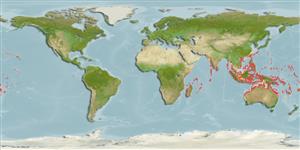Environment: milieu / climate zone / गहराई सीमा / distribution range
पारिस्थितिकी
समुद्री प्रवाल-भित्ति संयुक्त; गहराई सीमा 0 - 30 m (Ref. 5213). Tropical; 29°N - 34°S, 28°E - 157°W (Ref. 5222)
Indo-West Pacific: Natal, South Africa to the central Pacific. Not known from the Red Sea nor Persian Gulf.
आकार / वज़न / Age
परिपक्व अवधि: Lm ? range ? - ? cm
Max length : 54.9 cm TL पुल्लिंग / अलिंग; (Ref. 125599); common length : 25.0 cm TL पुल्लिंग / अलिंग; (Ref. 9137); अधिकतम प्रकाशित वज़न: 3.8 kg (Ref. 125599)
पृष्ठीय रीढ़ (सम्पूर्ण) : 11; पृष्ठीय सौफट रेज़ (सम्पूर्ण) : 14 - 16; गुदा कांटा: 3; ऐनल सौफट रेज़: 8. A single large black blotch along middle of dorsal fin base (Ref. 37816), which can be turned off (Ref. 48635); further characterized by head, body and fins having numerous close-set polygon shaped dark brown spots; broad zone along side of body with ctenoid scales, cycloid scales elsewhere; body with auxiliary scales; greatest depth of body 2.9-3.4 in SL; rounded caudal fin; short pelvic fins, 2.0-2.6 in head length (Ref. 90102); head length 2.2-2.4 in SL; flat or slightly concave interorbital area; rounded preopercle, serrae mostly covered by skin; straight or slightly convex upper edge of operculum; subequal posterior and anterior nostrils; maxilla reaches to or past vertical at rear edge of eye; 3-5 rows of teeth on midlateral part of lower jaw, inner teeth about twice as long as outer ones (Ref. 89707).
Body shape (shape guide): fusiform / normal; Cross section: compressed.
Occur in outer reef flats and shallow lagoon (Ref. 37816). Reported to be taken in a trawl, thus presumably caught somewhat deeper than 7 m. Also reported to occur in reefs at a depth of about 30 m (Ref. 5213). Because of its small size and apparent rarity, it is of little or no commercial importance. Solitary (Ref 90102).
Life cycle and mating behavior
परिपक्व अवधि | पुनरुत्पत्ति | मछलीऔ का अंडे देना | अंडे | Fecundity | लार्वा
Heemstra, P.C. and J.E. Randall, 1993. FAO Species Catalogue. Vol. 16. Groupers of the world (family Serranidae, subfamily Epinephelinae). An annotated and illustrated catalogue of the grouper, rockcod, hind, coral grouper and lyretail species known to date. Rome: FAO. FAO Fish. Synop. 125(16):382 p. (Ref. 5222)
IUCN Red List Status (Ref. 130435: Version 2025-1)
Threat to humans
Reports of ciguatera poisoning (Ref. 31637)
Human uses
मात्स्यिकी: निर्वाह मात्स्यिकी
साधन
Special reports
Download XML
इंटरनेट स्रोत
Estimates based on models
Preferred temperature (संदर्भ
123201): 24.9 - 29.3, mean 28.4 °C (based on 2734 cells).
Phylogenetic diversity index (संदर्भ
82804): PD
50 = 0.5000 [Uniqueness, from 0.5 = low to 2.0 = high].
Bayesian length-weight: a=0.01175 (0.00681 - 0.02028), b=3.05 (2.91 - 3.19), in cm total length, based on LWR estimates for this species & Genus-body shape (Ref.
93245).
Trophic level (संदर्भ
69278): 4.0 ±0.67 se; based on food items.
लौटाव (संदर्भ
120179): माध्यम, न्यूनतम जनसंख्या दुगनी होने का समय 1.4 - 4.4 वर्ष। (Preliminary K or Fecundity.).
Fishing Vulnerability (Ref.
59153): Moderate vulnerability (42 of 100).
🛈
Nutrients (Ref.
124155): Calcium = 37.4 [18.0, 75.7] mg/100g; Iron = 0.522 [0.288, 1.088] mg/100g; Protein = 18.5 [17.0, 19.9] %; Omega3 = 0.125 [0.079, 0.199] g/100g; Selenium = 27 [16, 48] μg/100g; VitaminA = 232 [64, 837] μg/100g; Zinc = 1.42 [0.97, 1.99] mg/100g (wet weight);
